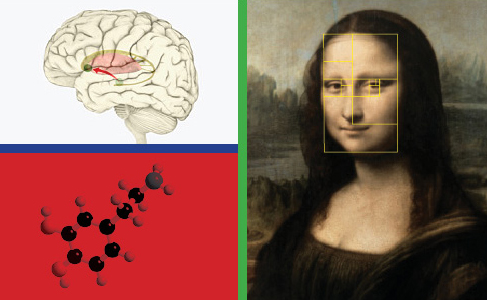
Artwork by the author.
Have you ever wondered why we find some people attractive, are drawn to a verdant landscape, enjoy looking at a great work of art or drool over a sleek sports car? We seek out these aesthetic experiences because they make us feel good. Still the questions of how and why our brains create such pleasurable sensations has--until recently--been one of the great mysteries of life.
But now, science is starting to answer this age-old question. Neuroscientists are using advanced scanning machines to look inside the living human brain and figure out why we like what we like.
And what they're discovering is astounding!
It turns out, the parts of our brains that give us a good feeling when we experience beauty are the same parts that are responsible for the drive to survive. Here's how it works. Each of us has a set of structures in our subconscious brain called the reward system. It has evolved over time to help us spot those people, places and things that could help us survive. The reward system signals the presence of survival advantages by producing the feel-good chemical, dopamine, the effect of which our consciousness interprets as, "Hey, there's someone (or something) I like!" We get the delicious sensation that our human needs are being met and we pursue whomever or whatever triggered the dopamine rush.

The link between survival and finding a good mate or a hospitable environment is clear. We find some people attractive because they have good genes and can help us extend our own genetic lines. We are drawn to lush landscapes because they can provide us with the necessities of life.
But we also feel attraction to those things that are purely the product of human creativity. I'm talking about the things artists and designers create out of whole cloth, like cars, clothing, computers, furniture, appliances and even advertisements, typefaces and product packaging. Why do these things--when they are well designed--have the power to stimulate our survival centers, trigger the aesthetic experience, give us a good feeling and make us want to possess them?

One study that sheds some light on the mystery was conducted at the Neuroscience Department of the University of Parma, Italy. Researchers sought to discover what kind of visual stimuli caused the reward system to activate and produce dopamine. Subjects were shown images of the classical sculpture, Doryphoros by Polykleitos, which is based on a set of proportions called the golden section. Images of the sculpture were shown three different ways; with its original proportions, with the legs shortened, and with the trunk lengthened. Researchers used an advanced MRI scanner to watch how the subjects' brains responded and found that the sculpture with its original proportions produced the most pronounced emotional effect.
It makes sense that the golden section can trigger our reward systems. After all, artists and designers have been aware of its aesthetic power for a very long time and many ancient and modern works of art such as the Parthenon and the Mona Lisa reveal its presence. It also shows up throughout the fabric of life. It can be seen in the arrangement of leaves on many plants and in the scale and anatomy of our own bodies. It's even found in our DNA!
Perhaps our subconscious brains respond to the golden section because it signals the presence of a survival advantage. It's not too great a stretch to imagine that we would be attracted to another person whose appearance represents a particularly elegant example of the golden section, or that we are drawn to a landscape that somehow incorporates multiple golden sections.
The case of the golden section is only one example. As with the study of most other phenomena, this line of research produces more questions than answers. But three principles are clear:
- We don't consciously choose to like other people and things, our subconscious makes those decisions for us.
- Our sense of attraction is closely associated with our drive to survive.
- Our attraction to other people, places and things happens very quickly--usually within 3 seconds.
It's a delicious mystery and more research is sure to provide exciting revelations about why we like what we like. What other new ideas will future study inspire? Stay tuned and we'll explore them together.
Darby Roach is a designer and a writer and heads up his own marketing agency, Orbit Direct. His most recent book, Your Three Second Window, demystifies the design process by explaining why we like the things we like, how to see and think as a designer, and what each of us can do to introduce harmony into our lives through an enhanced aesthetic experience.
Find out more about Darby and follow his blog at DarbyRoach.com
Follow Darby Roach on Twitter: www.twitter.com/darbyroach

No comments:
Post a Comment